EGN-3333 Spring 2018: Chemical Hazards, Risks, and PPE Lab Report
VerifiedAdded on 2023/06/11
|8
|842
|424
Report
AI Summary
This report details the identification of chemical hazards and the use of Personal Protective Equipment (PPE) in a workplace setting. It highlights the risks associated with chemical exposure, including both immediate and long-term health effects, and emphasizes the importance of hazard classification and corrective controls. The report references Material Safety Data Sheets (MSDS) and discusses various types of chemical agents and their potential damages, such as respiratory problems, organ failure, and skin diseases. It also underscores the role of PPE in mitigating chemical hazards and the need for proper training and safety procedures to reduce the number of incidents. The report concludes that with appropriate measures, training, and first aid arrangements, organizations can significantly minimize the risks associated with chemical hazards.
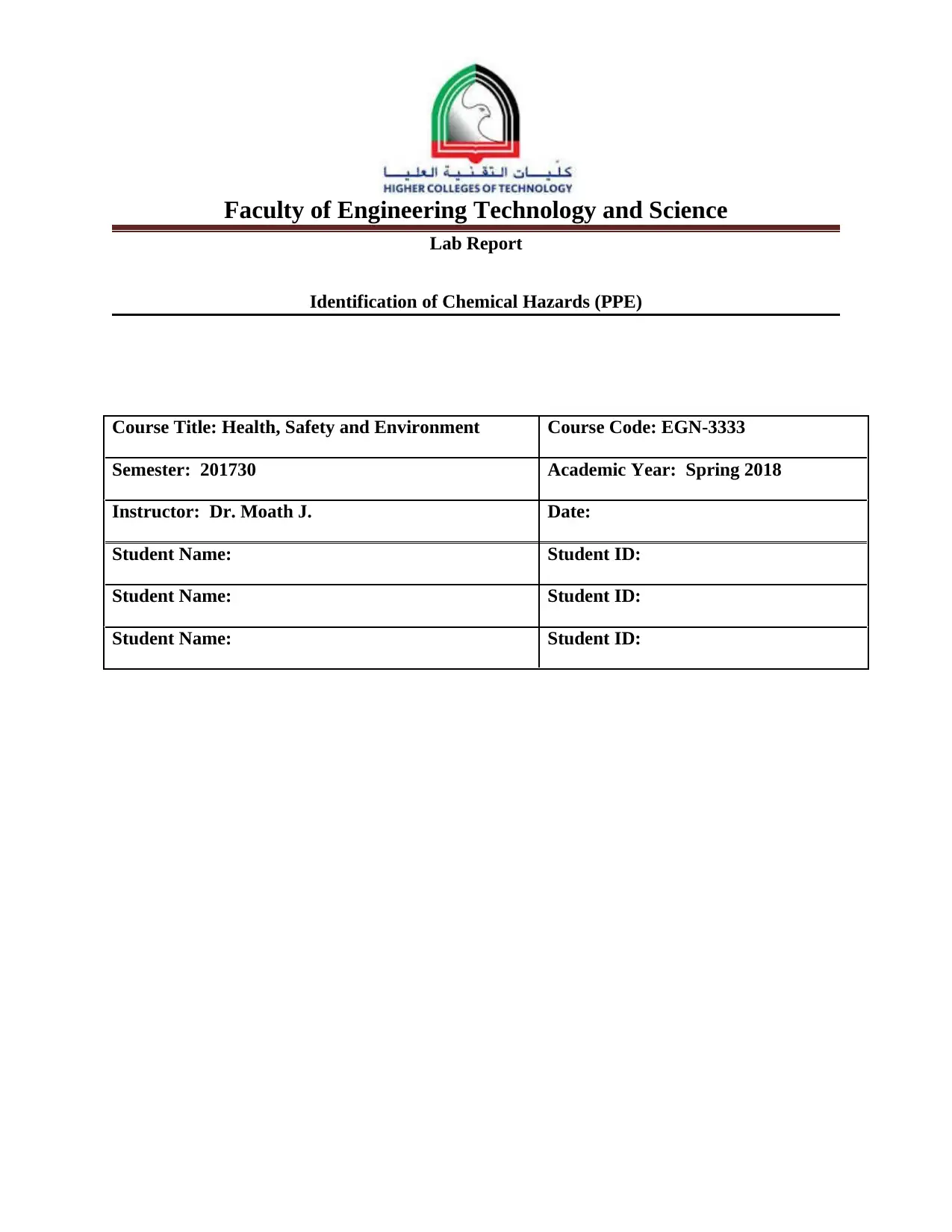
Faculty of Engineering Technology and Science
Lab Report
Identification of Chemical Hazards (PPE)
Course Title: Health, Safety and Environment Course Code: EGN-3333
Semester: 201730 Academic Year: Spring 2018
Instructor: Dr. Moath J. Date:
Student Name: Student ID:
Student Name: Student ID:
Student Name: Student ID:
Lab Report
Identification of Chemical Hazards (PPE)
Course Title: Health, Safety and Environment Course Code: EGN-3333
Semester: 201730 Academic Year: Spring 2018
Instructor: Dr. Moath J. Date:
Student Name: Student ID:
Student Name: Student ID:
Student Name: Student ID:
Paraphrase This Document
Need a fresh take? Get an instant paraphrase of this document with our AI Paraphraser
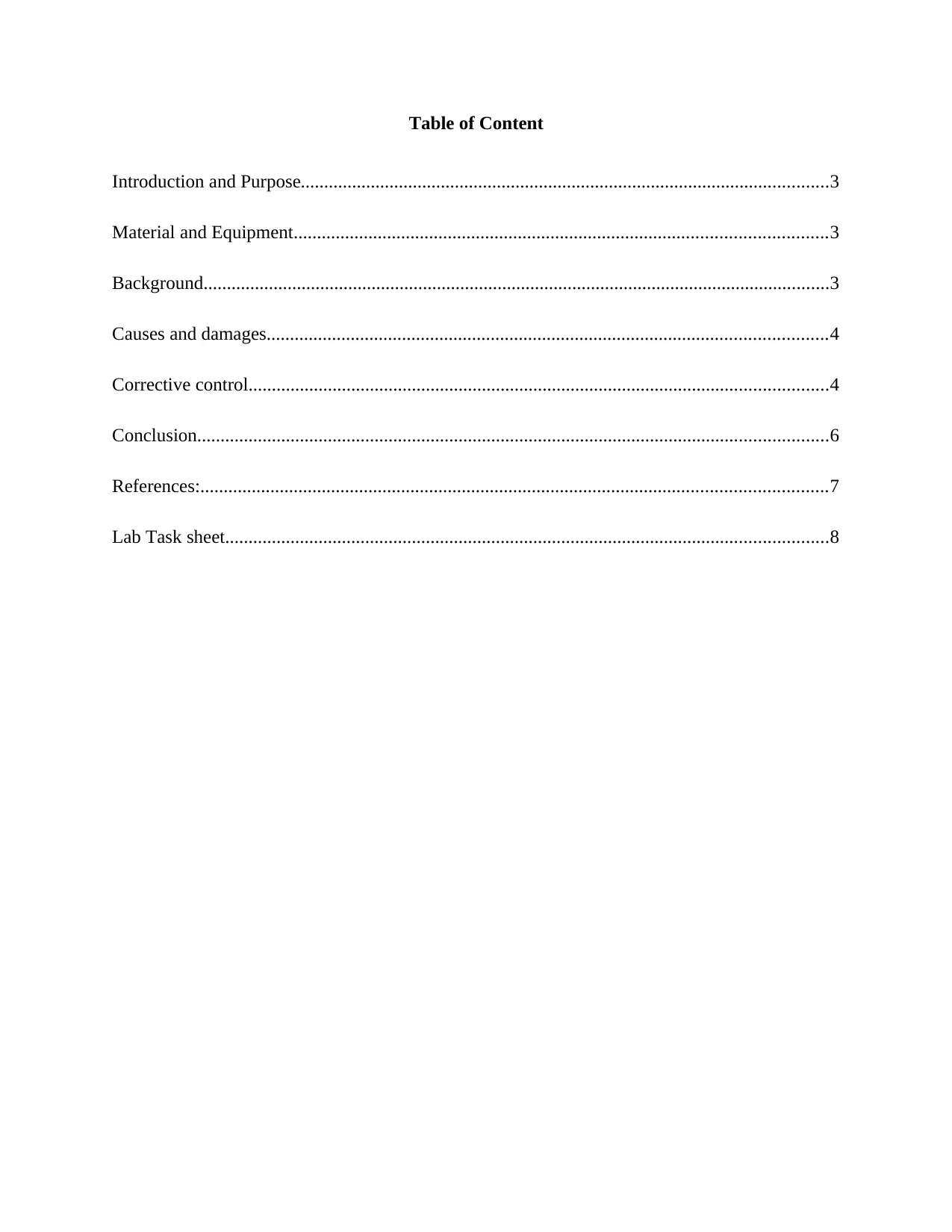
Table of Content
Introduction and Purpose.................................................................................................................3
Material and Equipment..................................................................................................................3
Background......................................................................................................................................3
Causes and damages........................................................................................................................4
Corrective control............................................................................................................................4
Conclusion.......................................................................................................................................6
References:......................................................................................................................................7
Lab Task sheet.................................................................................................................................8
Introduction and Purpose.................................................................................................................3
Material and Equipment..................................................................................................................3
Background......................................................................................................................................3
Causes and damages........................................................................................................................4
Corrective control............................................................................................................................4
Conclusion.......................................................................................................................................6
References:......................................................................................................................................7
Lab Task sheet.................................................................................................................................8
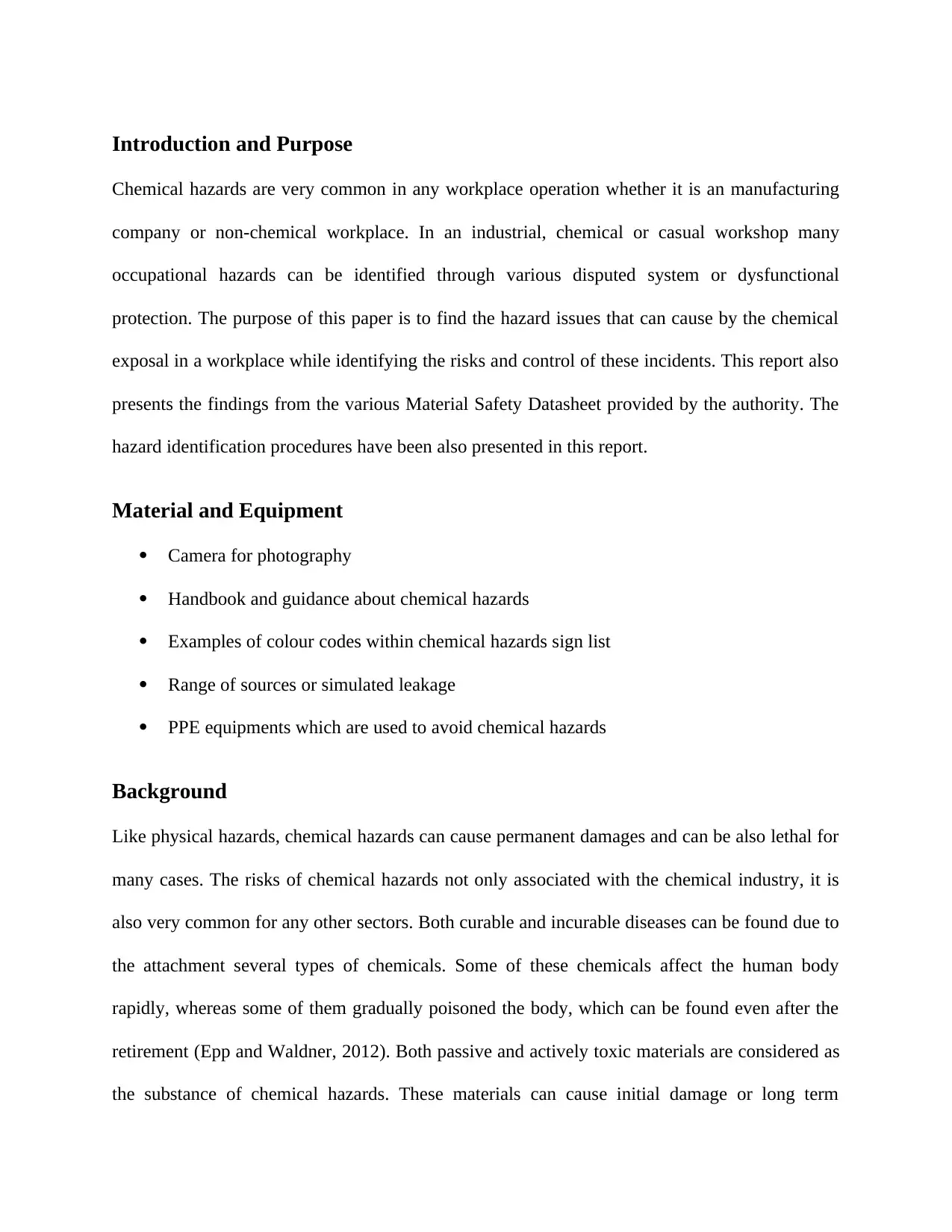
Introduction and Purpose
Chemical hazards are very common in any workplace operation whether it is an manufacturing
company or non-chemical workplace. In an industrial, chemical or casual workshop many
occupational hazards can be identified through various disputed system or dysfunctional
protection. The purpose of this paper is to find the hazard issues that can cause by the chemical
exposal in a workplace while identifying the risks and control of these incidents. This report also
presents the findings from the various Material Safety Datasheet provided by the authority. The
hazard identification procedures have been also presented in this report.
Material and Equipment
Camera for photography
Handbook and guidance about chemical hazards
Examples of colour codes within chemical hazards sign list
Range of sources or simulated leakage
PPE equipments which are used to avoid chemical hazards
Background
Like physical hazards, chemical hazards can cause permanent damages and can be also lethal for
many cases. The risks of chemical hazards not only associated with the chemical industry, it is
also very common for any other sectors. Both curable and incurable diseases can be found due to
the attachment several types of chemicals. Some of these chemicals affect the human body
rapidly, whereas some of them gradually poisoned the body, which can be found even after the
retirement (Epp and Waldner, 2012). Both passive and actively toxic materials are considered as
the substance of chemical hazards. These materials can cause initial damage or long term
Chemical hazards are very common in any workplace operation whether it is an manufacturing
company or non-chemical workplace. In an industrial, chemical or casual workshop many
occupational hazards can be identified through various disputed system or dysfunctional
protection. The purpose of this paper is to find the hazard issues that can cause by the chemical
exposal in a workplace while identifying the risks and control of these incidents. This report also
presents the findings from the various Material Safety Datasheet provided by the authority. The
hazard identification procedures have been also presented in this report.
Material and Equipment
Camera for photography
Handbook and guidance about chemical hazards
Examples of colour codes within chemical hazards sign list
Range of sources or simulated leakage
PPE equipments which are used to avoid chemical hazards
Background
Like physical hazards, chemical hazards can cause permanent damages and can be also lethal for
many cases. The risks of chemical hazards not only associated with the chemical industry, it is
also very common for any other sectors. Both curable and incurable diseases can be found due to
the attachment several types of chemicals. Some of these chemicals affect the human body
rapidly, whereas some of them gradually poisoned the body, which can be found even after the
retirement (Epp and Waldner, 2012). Both passive and actively toxic materials are considered as
the substance of chemical hazards. These materials can cause initial damage or long term
⊘ This is a preview!⊘
Do you want full access?
Subscribe today to unlock all pages.

Trusted by 1+ million students worldwide
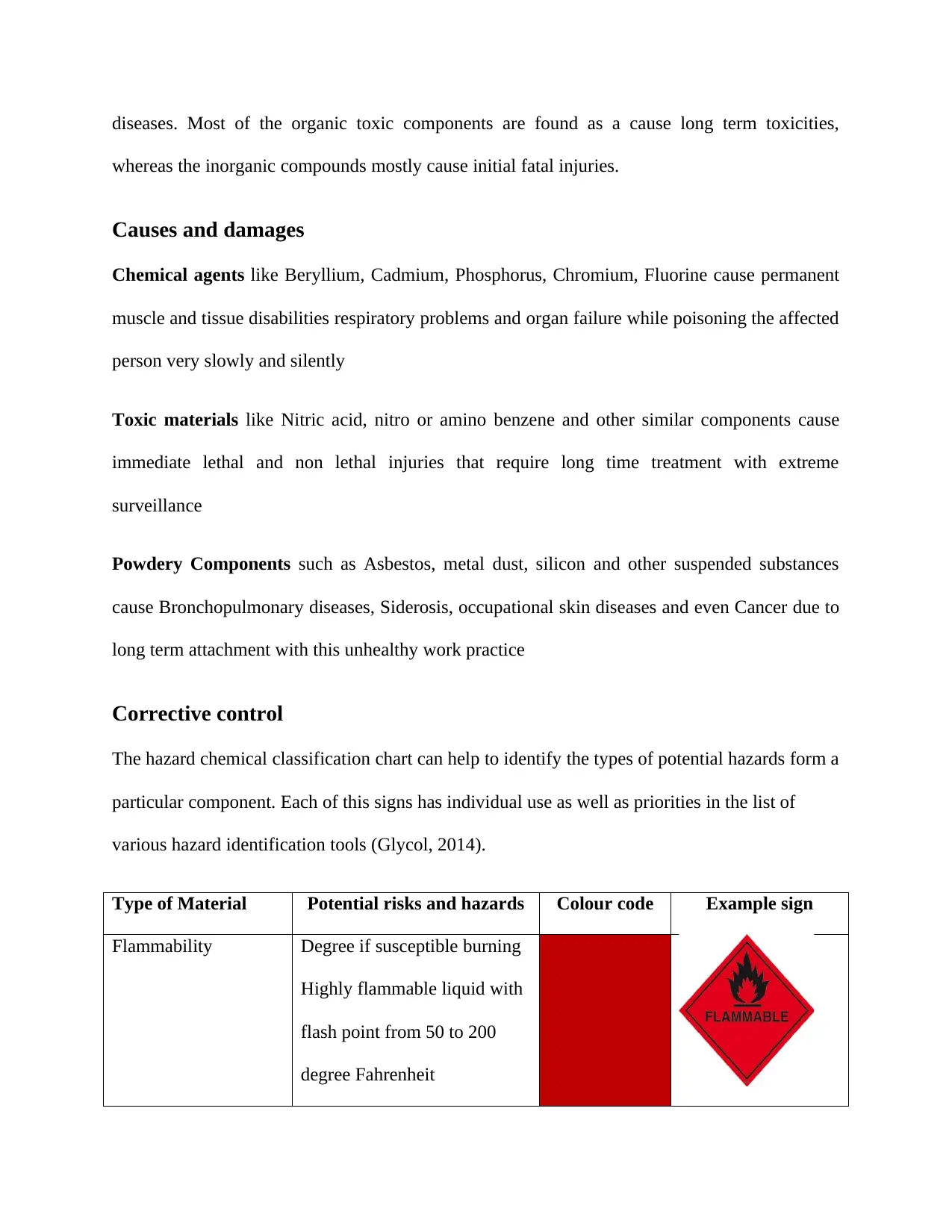
diseases. Most of the organic toxic components are found as a cause long term toxicities,
whereas the inorganic compounds mostly cause initial fatal injuries.
Causes and damages
Chemical agents like Beryllium, Cadmium, Phosphorus, Chromium, Fluorine cause permanent
muscle and tissue disabilities respiratory problems and organ failure while poisoning the affected
person very slowly and silently
Toxic materials like Nitric acid, nitro or amino benzene and other similar components cause
immediate lethal and non lethal injuries that require long time treatment with extreme
surveillance
Powdery Components such as Asbestos, metal dust, silicon and other suspended substances
cause Bronchopulmonary diseases, Siderosis, occupational skin diseases and even Cancer due to
long term attachment with this unhealthy work practice
Corrective control
The hazard chemical classification chart can help to identify the types of potential hazards form a
particular component. Each of this signs has individual use as well as priorities in the list of
various hazard identification tools (Glycol, 2014).
Type of Material Potential risks and hazards Colour code Example sign
Flammability Degree if susceptible burning
Highly flammable liquid with
flash point from 50 to 200
degree Fahrenheit
whereas the inorganic compounds mostly cause initial fatal injuries.
Causes and damages
Chemical agents like Beryllium, Cadmium, Phosphorus, Chromium, Fluorine cause permanent
muscle and tissue disabilities respiratory problems and organ failure while poisoning the affected
person very slowly and silently
Toxic materials like Nitric acid, nitro or amino benzene and other similar components cause
immediate lethal and non lethal injuries that require long time treatment with extreme
surveillance
Powdery Components such as Asbestos, metal dust, silicon and other suspended substances
cause Bronchopulmonary diseases, Siderosis, occupational skin diseases and even Cancer due to
long term attachment with this unhealthy work practice
Corrective control
The hazard chemical classification chart can help to identify the types of potential hazards form a
particular component. Each of this signs has individual use as well as priorities in the list of
various hazard identification tools (Glycol, 2014).
Type of Material Potential risks and hazards Colour code Example sign
Flammability Degree if susceptible burning
Highly flammable liquid with
flash point from 50 to 200
degree Fahrenheit
Paraphrase This Document
Need a fresh take? Get an instant paraphrase of this document with our AI Paraphraser
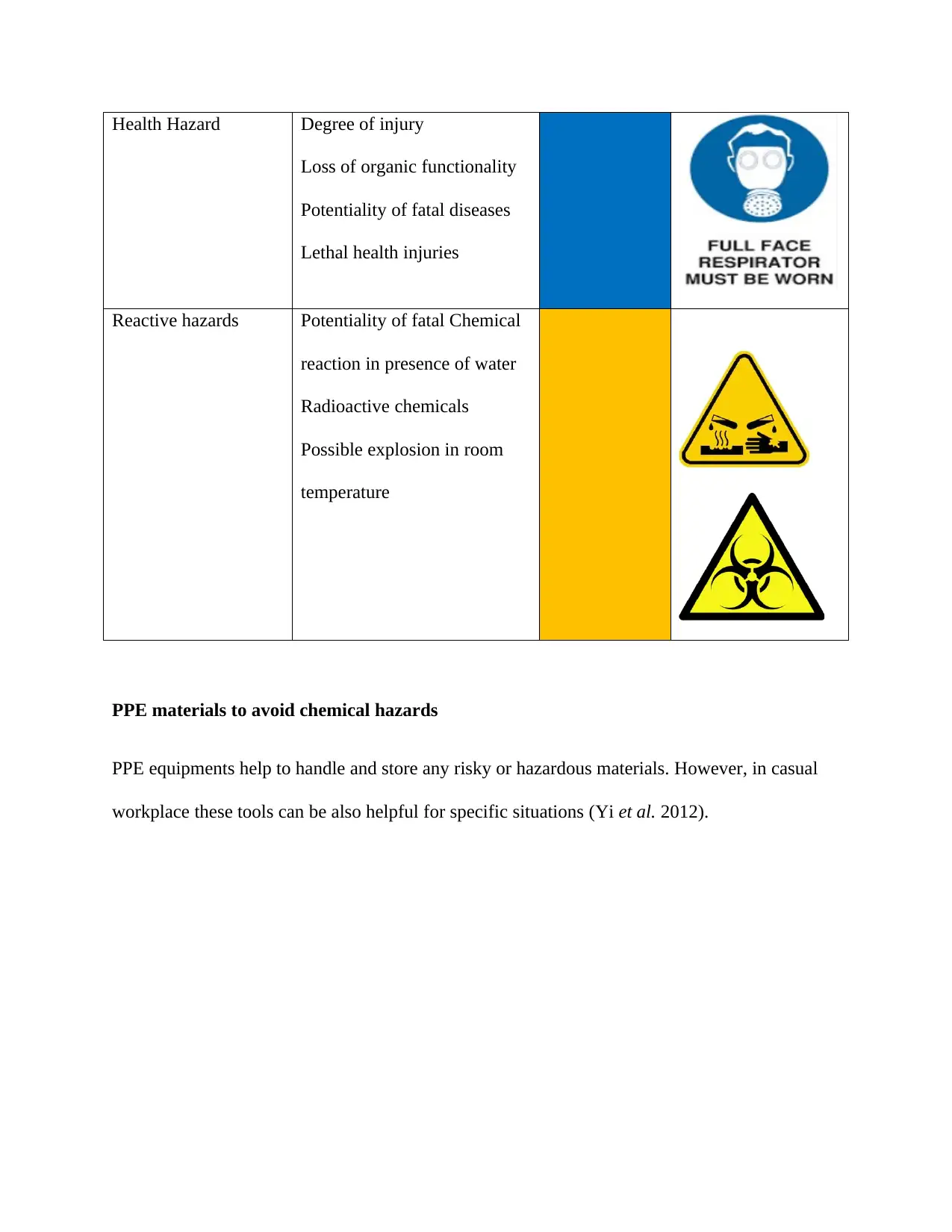
Health Hazard Degree of injury
Loss of organic functionality
Potentiality of fatal diseases
Lethal health injuries
Reactive hazards Potentiality of fatal Chemical
reaction in presence of water
Radioactive chemicals
Possible explosion in room
temperature
PPE materials to avoid chemical hazards
PPE equipments help to handle and store any risky or hazardous materials. However, in casual
workplace these tools can be also helpful for specific situations (Yi et al. 2012).
Loss of organic functionality
Potentiality of fatal diseases
Lethal health injuries
Reactive hazards Potentiality of fatal Chemical
reaction in presence of water
Radioactive chemicals
Possible explosion in room
temperature
PPE materials to avoid chemical hazards
PPE equipments help to handle and store any risky or hazardous materials. However, in casual
workplace these tools can be also helpful for specific situations (Yi et al. 2012).
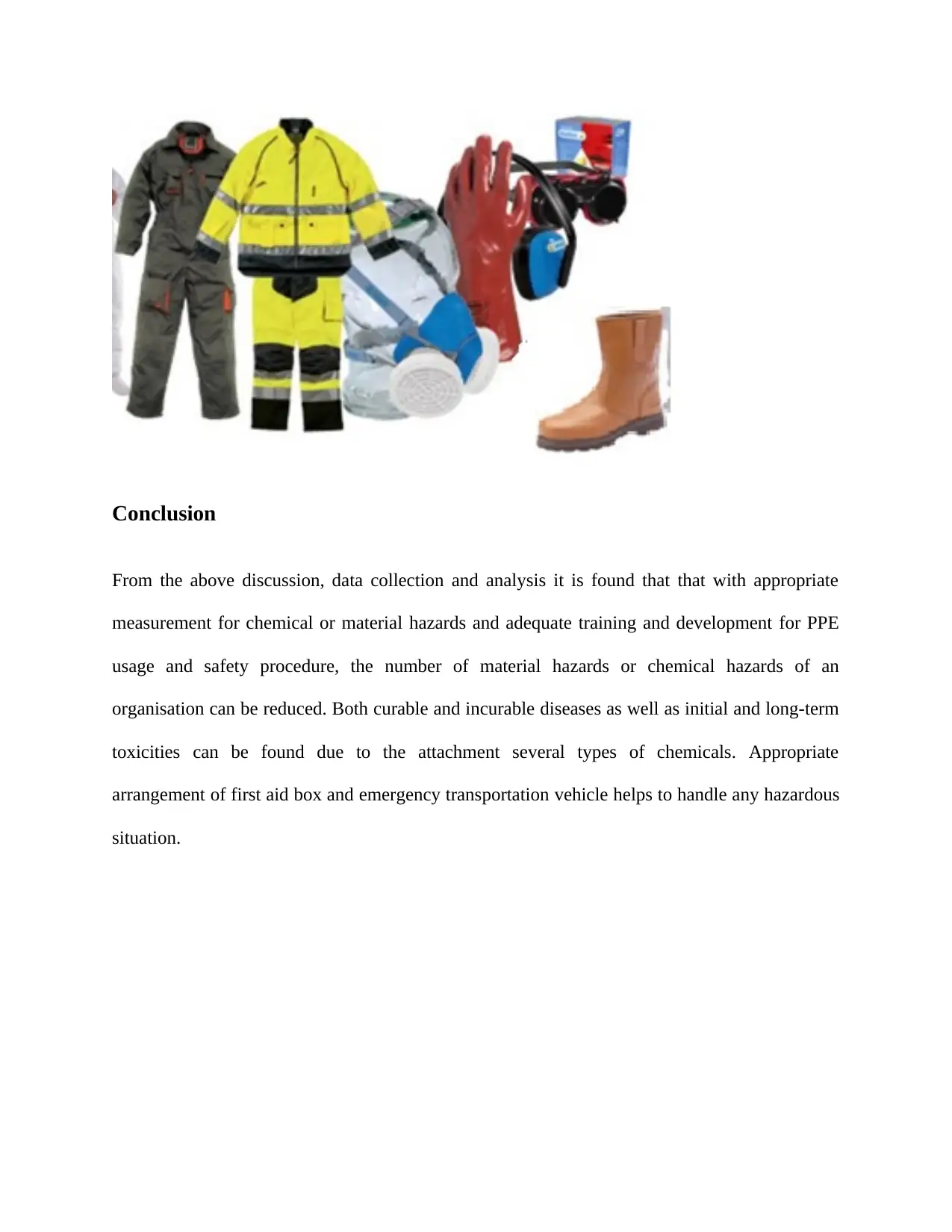
Conclusion
From the above discussion, data collection and analysis it is found that that with appropriate
measurement for chemical or material hazards and adequate training and development for PPE
usage and safety procedure, the number of material hazards or chemical hazards of an
organisation can be reduced. Both curable and incurable diseases as well as initial and long-term
toxicities can be found due to the attachment several types of chemicals. Appropriate
arrangement of first aid box and emergency transportation vehicle helps to handle any hazardous
situation.
From the above discussion, data collection and analysis it is found that that with appropriate
measurement for chemical or material hazards and adequate training and development for PPE
usage and safety procedure, the number of material hazards or chemical hazards of an
organisation can be reduced. Both curable and incurable diseases as well as initial and long-term
toxicities can be found due to the attachment several types of chemicals. Appropriate
arrangement of first aid box and emergency transportation vehicle helps to handle any hazardous
situation.
⊘ This is a preview!⊘
Do you want full access?
Subscribe today to unlock all pages.

Trusted by 1+ million students worldwide
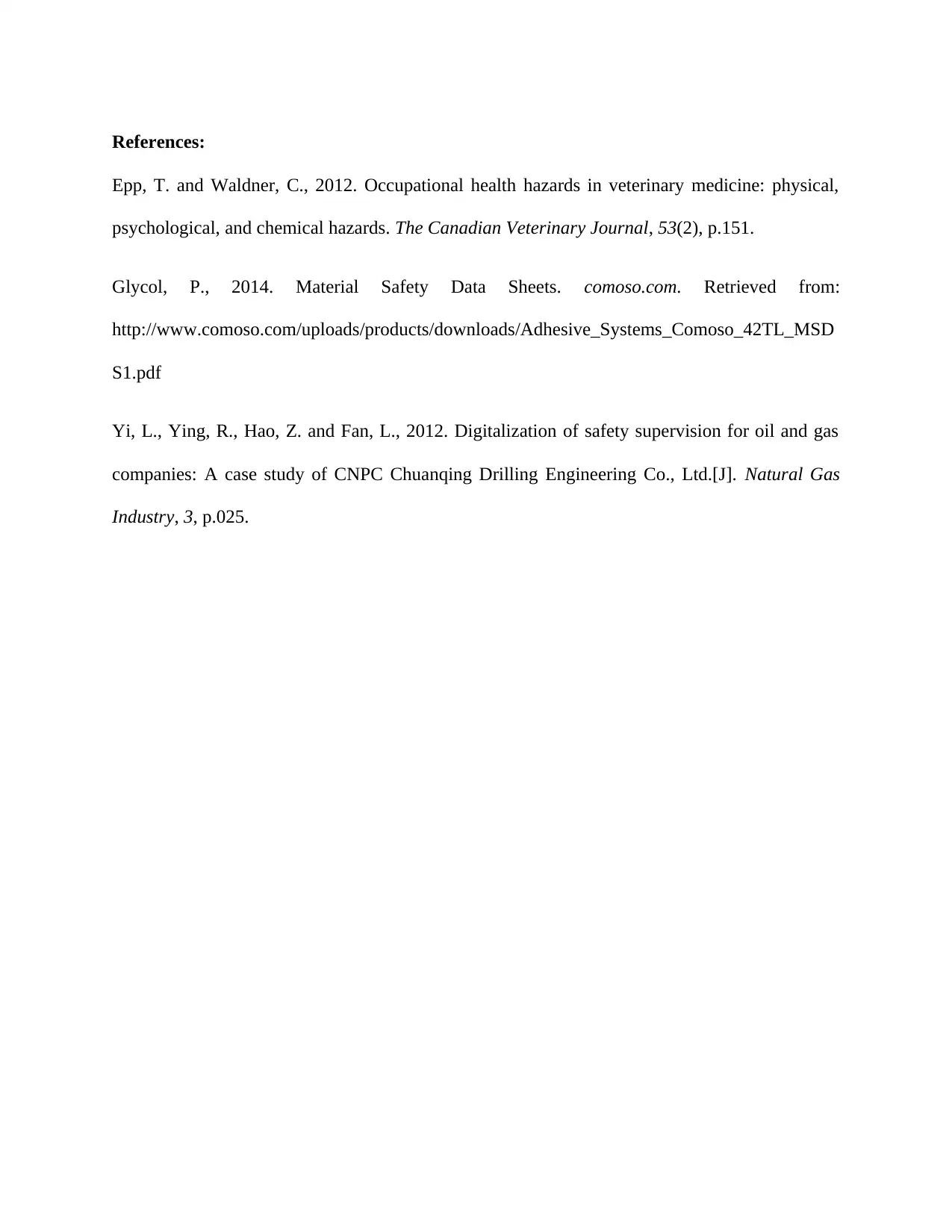
References:
Epp, T. and Waldner, C., 2012. Occupational health hazards in veterinary medicine: physical,
psychological, and chemical hazards. The Canadian Veterinary Journal, 53(2), p.151.
Glycol, P., 2014. Material Safety Data Sheets. comoso.com. Retrieved from:
http://www.comoso.com/uploads/products/downloads/Adhesive_Systems_Comoso_42TL_MSD
S1.pdf
Yi, L., Ying, R., Hao, Z. and Fan, L., 2012. Digitalization of safety supervision for oil and gas
companies: A case study of CNPC Chuanqing Drilling Engineering Co., Ltd.[J]. Natural Gas
Industry, 3, p.025.
Epp, T. and Waldner, C., 2012. Occupational health hazards in veterinary medicine: physical,
psychological, and chemical hazards. The Canadian Veterinary Journal, 53(2), p.151.
Glycol, P., 2014. Material Safety Data Sheets. comoso.com. Retrieved from:
http://www.comoso.com/uploads/products/downloads/Adhesive_Systems_Comoso_42TL_MSD
S1.pdf
Yi, L., Ying, R., Hao, Z. and Fan, L., 2012. Digitalization of safety supervision for oil and gas
companies: A case study of CNPC Chuanqing Drilling Engineering Co., Ltd.[J]. Natural Gas
Industry, 3, p.025.
Paraphrase This Document
Need a fresh take? Get an instant paraphrase of this document with our AI Paraphraser

Lab Task sheet
1 out of 8
Related Documents
Your All-in-One AI-Powered Toolkit for Academic Success.
+13062052269
info@desklib.com
Available 24*7 on WhatsApp / Email
![[object Object]](/_next/static/media/star-bottom.7253800d.svg)
Unlock your academic potential
Copyright © 2020–2025 A2Z Services. All Rights Reserved. Developed and managed by ZUCOL.





